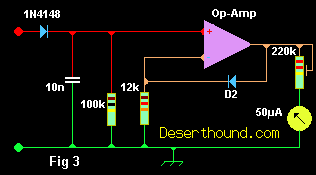Simple diode detectors are not linear. There is a small forward voltage drop across the diode, and this voltage varies with diode current. Even if we allow for a fixed voltage drop across the diode, measurements will not be accurate at all power levels. At 1mA of diode current, the drop across a Schottky signal diode will be about 0.3V. At very low diode currents of around 1µA the drop will be much lower, typically about 0.1V.
This is not too much of a problem at higher power levels because an error of a fraction of a volt is quite a small percentage of a total peak voltage of several tens of volts. We can choose to ignore it or partially compensate by adding a fixed offset to the measured value. About O.6V for a silicon diode or O.3V for a Schottky signal diode such as 1N5711 or BAT 43 is close enough to be reasonably accurate. However, at very low power levels, the voltage drop is a significant fraction of the peak voltage and will lead to increasing errors as the peak voltage is reduced. For example, if the peak voltage is 500mV (+4dBm, or 2.5mW), a voltage drop of 0.2V across the detector diode would result in a measured peak voltage of just 300mV (0.46dBm, or 0.9mW). This problem gets even worse when the peak voltage input approaches 0.1-0.2V and the detector output voltage is close to zero.

There are a number of ways to improve the accuracy of a diode peak voltage detector. We could calibrate the meter by hand to eliminate errors at the lower end of the scale. This approach works well in practice but it is time consuming and requires unique calibration curves for individual diodes.
We could apply a small amount of forward bias to the diode which would reduce the voltage drop for RF signals or we could use a second identical diode as a reference to show us the required offset for a given level of current and diode temperature. It would be possible to apply all three methods to obtain the best possible accuracy but to keep things simple; I will adopt only the last method. Figure 3 shows how an opamp and a second diode can be arranged to compensate for the voltage drop of the detector diode. This circuit is due to KI6WX [2]. When used with a closely matched pair of 1N5711 diodes, this circuit will accurately track the input voltage down to a level of well below 0.1 V (-10dBm, or 100µW). If the circuit is to be used with a single-ended power supply, the opamp input and output voltage range must go all the way down to the negative supply rail. I used one half of an LM358. A CMOS input type like the CA3140 would be capable of even better performance.
Facing Bithumb refunding issues? Want help to fix the issue as soon as possible? Unaware of the causes behind this error? If yes, take one easy step dial Bithumb Support Number at 1888-764-0492 and get your issues fixed by the A-rated and accomplished experts who have multiple solutions to every single error. The experts are aware of the fact that users don’t have that vary knowledge so they tell each and every solution in most basic and convenient way.Visit website:-http://www.cryptophonesupport.com/exchange/bithumb
ReplyDelete